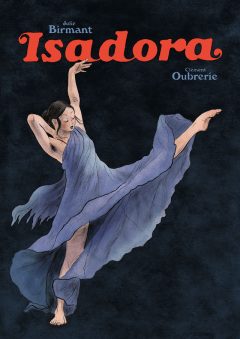Review: Isadora (SelfMadeHero)
Isadora is a beautifully drawn comic book written by Julie Birmant and drawn by Clément Oubrere. They combine to write an intriguing biography about one of the art world’s lesser-known but extremely influential figures, Isadora Duncan.
 Publisher: SelfMadeHero
Publisher: SelfMadeHero
Writer: Julie Birmant
Artist: Clément Oubrere
Price: £14.99 from Amazon
Isadora Duncan, who performed across Europe, was known as ‘The Mother of Modern Dance’ and Birmant tells her story through Oubrere’s fantastic artwork.
We join Isadora’s story, at a point where she has already become a famous dancer, on a plane with her husband, the Russian poet Sergei Yesenin. From there we go on a whistle stop tour of her journey from relative nobody to the becoming ‘he Mother of Modern Dance.’
Birmant depicts Isadora as a free-spirited woman is who is totally assured of herself and her ability to dance. Oubrere manages to capture this visually with flowing images through the use of a mixture colouring techniques.
This comic is colourful, like its protagonaist, but the story is a rollercoaster of emotion. Isadora’s dramatic personality drove an eventful life which we are lead to believe she embraced whole-heartedly.
Julie Birmant is a writer and filmmaker based in Paris. She has written plays and documentaries for several media outlets and has already dipped into the world of la bande dessinée with her début Drôles de Femmes, an illustrated collection of potraits of influential female figures.
Clément Oubrere is a French comic book artist, who is also based in Paris, and previously collaborated with Birmant on Pablo, their biography of Spanish artist Pablo Picasso. He was nominated for the Eisner award for his graphic novel Aya: Life in Yop City.
In Isadora they have found an unusual and interesting biographical topic. Isadora took influence from Greek mythology and artists to inspire her dance moves. We are treated to views on Isadora’s personal and professional life as she searches for success and love.
The artwork is clever. The backgrounds aren’t terribly detailed but Oubrere manages to fill the panels with action and depictions of Europe in the first half of the twentieth century.
The toned down background detail leaves plenty of room for Isadora to take centre stage, as she would have done in her live performances in theatres across Europe. You are left in no doubt as to who is the star of the show.
The story is set out in chronologically labelled chapters, after the introduction and you are perhaps left wanting to know a little more about her life as her career wound down and what it was like just before her death.
These are, however, points made when you want to learn more about Isadora Duncan having read the book. The focal point – her dancing career – is fully detailed and you are treated to an unexpected pleasure.



July 16, 2025 @ 1:57 am
I don’t think the title of your article matches the content lol. Just kidding, mainly because I had some doubts after reading the article.
July 22, 2025 @ 9:56 pm
Thank you for writing this article. I appreciate the subject too. http://www.hairstylesvip.com
July 24, 2025 @ 6:26 am
Good web site! I truly love how it is easy on my eyes and the data are well written. http://www.kayswell.com I am wondering how I could be notified whenever a new post has been made. I’ve subscribed to your RSS which must do the trick! Have a nice day!
July 24, 2025 @ 8:02 pm
I do not even know how I ended up here, but I thought this post was good. I don’t know who you are but certainly you are going to a famous blogger if you are not already 😉 Cheers!
July 26, 2025 @ 1:47 am
Hi there! I know this is kinda off topic but I’d figured I’d ask. Would you be interested in trading links or maybe guest authoring a blog article or vice-versa? My website discusses a lot of the same topics as yours and I feel we could greatly benefit from each other. If you happen to be interested feel free to shoot me an e-mail. I look forward to hearing from you! Fantastic blog by the way!
July 28, 2025 @ 1:37 pm
Please tell me more about your excellent articles http://www.kayswell.com
July 28, 2025 @ 10:08 pm
Your articles are extremely helpful to me. Please provide more information! http://www.kayswell.com
July 29, 2025 @ 5:47 am
May I request that you elaborate on that? http://www.kayswell.com Your posts have been extremely helpful to me. Thank you!
August 20, 2025 @ 6:59 pm
Thanks for sharing. I read many of your blog posts, cool, your blog is very good. https://www.binance.com/hu/register?ref=FIHEGIZ8